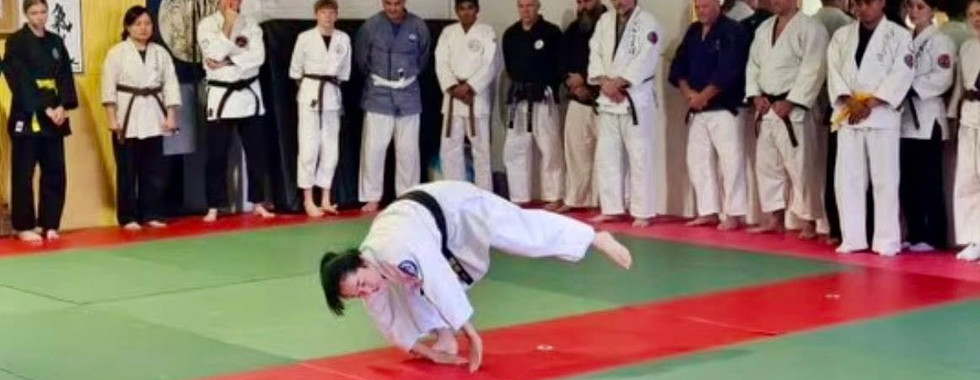Perth Australia Dojo Tour – Yamato International Aikido
- Yoshie Sugai

- Jul 23
- 3 min read
The seventh stop on our Perth Dojo Tour was a seminar hosted by Yamato International Aikido, led by Head Instructor Murat Sensei, where I had the honor of teaching alongside Ezawa Sensei. The seminar was attended by instructors and students from several of the dojos we had visited during this tour, creating an energetic and collaborative learning environment.
日本語はこちら
1) Children’s Class – Developing the Ability to Escape, Not Just Apply Techniques
In the children’s class, we focused not on teaching techniques but on fun exercises that build strength, agility, and reflexes—foundational skills critical for young practitioners. This approach aligns with the philosophy of Minoru Mochizuki Sensei, who believed that children should first develop strong, flexible bodies through judo rather than aikido techniques.
At my own dojo, I follow the teachings of Kinefuchi Shihan, who emphasized that children must first learn to escape from danger rather than apply techniques. During this class, we introduced three types of drills aimed at improving muscle strength, jumping ability, and reflexes.
While it’s natural for children to want to demonstrate “impressive” techniques—especially in front of an audience—the role of the instructor is to teach them something far more important: the ability to sense danger, avoid it, and have the courage and knowledge to escape. We must never instill the dangerous illusion that a child can successfully apply a technique on an adult. That is why we chose to demonstrate these exercises—for both the children and the instructors observing.
2) Adult Class – What Is the True Purpose of Budo?
In the adult session, I spoke about the fundamental purpose of budo, a topic I hoped would resonate particularly with yudansha (black belts and above). While each person may have their own reasons for practicing martial arts, it is vital for advanced practitioners to remember that budo is not just about perfecting techniques.
Today’s world is sadly marked by increasing violence, and even within martial arts circles, we sometimes see instructors who focus solely on technical mastery. But we must never forget that budo is education.
Jigoro Kano transformed traditional, often dangerous martial techniques into safer, structured methods that allowed students to learn life principles through practice. Minoru Mochizuki Sensei clearly explained that through budo, students should learn to cultivate ki (energy), tai (body), chi (wisdom), toku (virtue), and preparedness.
A dojo is not just a place to learn how to respond to attacks—it is a place to nurture individuals who will make society better and lead it toward peace. Martial artists must embrace the principle of “Seiryoku Zenyo, Jita Kyoei”—the idea of using one’s energy for good and creating mutual prosperity. That means engaging in positive, growth-oriented competition where all ability is directed toward beneficial ends.
3) Adult Class – The Importance of Ukemi
Another point I emphasized in the adult class was the importance of ukemi (falling techniques). Rather than complex or flashy techniques, ukemi is the foundation of all safe and effective martial arts practice.
Changing the way one has done ukemi for decades is not easy, but I believe that the open-minded and adaptable instructors in Australia can embrace new approaches. Having the courage and humility to let go of old methods and adopt something better is what defines a true martial artist.
4) Adult Class – Correct Application of "Motarekomi"
Finally, Ezawa Sensei shared his expertise on the proper application of “motarekomi” (body pressure techniques), building on the basic foundations I introduced.
He explained that a “kake” (throw) should not be performed simply to satisfy oneself, and that the “uke” (receiver) should not resist the attack but rather blend with it. True technique is achieved when both roles are in harmony.
He also emphasized that techniques must account for differences in size and strength, ensuring that no one gets hurt while still allowing the technique to be clearly applied. If the uke ends up with bruises or injuries, that is a sign that the technique is not being performed correctly.
In Closing
Some participants may have come expecting to see impressive or dramatic techniques, and perhaps a few were disappointed. But budo is not about showing off what we can do.
The true path of budo lies in continually asking: Why does this technique exist? How and why does it work? Exploring these deeper questions is what defines the “Do” in “budo.”
I believe many of the instructors who joined us for this seminar understood and appreciated this message. I am sincerely and deeply grateful to Murat Sensei for giving us the opportunity to share in such a meaningful and forward-looking experience that contributes to the future of budo.
























Comments